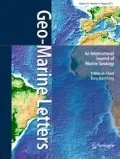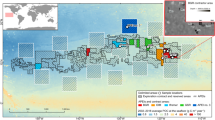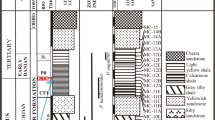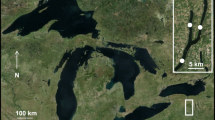Abstract
This study presents selected results of a sediment geochemical mapping program of German territorial waters in the south-western Baltic Sea. The field work was conducted mainly during the early 2000s. Due to the strong variability of sediment types in the study area, it was decided to separate and analyse the fine fraction (<63 μm, mud) from more than 600 surficial samples, combined with recalculations for the bulk sediment. For the contents of total organic carbon (TOC) and selected elements (P, Hg), the regional distribution maps show strong differences between the analysed fine fraction and the recalculated total sediment. Seeing that mud contents vary strongly between 0 and 100%, this can be explained by the well-known grain-size effect. To avoid (or at least minimise) this effect, further interpretations were based on the data for the fine fraction alone. Lateral transport from the large Oder River estuary combined with high abundances and activities of benthic fauna on the shallow-water Oder Bank (well sorted fine sand) could be some main causes for hotspots identified in the fine-fraction element distribution. The regional pattern of primary production as the main driver of nutrient element fixation (C, N, P, Si) was found to be only weakly correlated with, for example, the TOC distribution in the fine fraction. This implies that, besides surface sediment dynamics, local conditions (e.g. benthic secondary production) also have strong impacts. To the best of the authors’ knowledge, there is no comparable study with geochemical analyses of the fine fraction of marine sediments to this extent (13,600 km2) and coverage (between 600 and 800 data points) in the Baltic Sea. This aspect proved pivotal in confidently pinpointing geochemical “anomalies” in surface sediments of the south-western Baltic Sea.







Similar content being viewed by others
References
Beldowski J, Pempkowiak J (2003) Horizontal and vertical variabilities of mercury concentration and speciation in sediments of the Gdansk Basin, southern Baltic Sea. Chemosphere 52:645–654
Beldowski J, Pempkowiak J (2007) Mercury transformations in marine coastal sediments as derived from mercury concentration and speciation changes along source/sink transport pathway (southern Baltic). Estuarine, Coastal and Shelf Science 72:370–378
Borg H, Jonsson P (1996) Large-scale metal distribution in Baltic Sea sediments. Marine Pollution Bulletin 32:8–21
Bruggeman J, Bolding K (2014) A general framework for aquatic biogeochemical models. Environmental Modelling and Software 61:249–265
Burchard H, Bolding K (2002) GETM—A general estuarine transport model. Scientific documentation, tech Rept EUR 20253 EN
Christiansen C, Edelvang K, Emeis K-C, Graf G, Jähmlich S, Kozuch J, Laima M, Leipe T, Löffler A, Lund-Hansen L-C, Miltner A, Pazdro K, Pempkowiak J, Shimmield G, Shimmield T, Smith J, Voss M, Witt G (2002) Material transport from the nearshore to the basinal environment in the southern Baltic Sea, I: processes and mass estimates. Journal of Marine Systems 35:133–150
Conley DJ (1998) An interlaboratory comparison for the measurement of biogenic silica in sediments. Marine Chemistry 63:39–48
Darr A, Gogina M, Zettler ML (2014) Detecting hot-spots of bivalve biomass in the south-western Baltic Sea. Journal of Marine Systems 134:69–80
Doerffer R (2014) Algorithm theoretical bases document (ATBD) for L2 processing of MERIS data of case 2 waters, 4th reprocessing. ESA 20140825, MERIS ATBD 2.312
Emeis K-C, Christiansen C, Edelvang K, Jähmlich S, Kozuch J, Laima M, Leipe T, Lund-Hansen L-C, Löffler A, Miltner A, Pazdro K, Pempkowiak J, Pollehne F, Shimmield T, Voss M, Witt G (2002) Material transport from the nearshore to the basinal environment in the southern Baltic Sea, II: synthesis of data on origin and properties of material. Journal of Marine Systems 35:151–168
Emelyanov EM (ed) (2002) Geology of the Gdansk Basin, Baltic Sea. Russian Academy of Sciences, Shirshov Institute of Oceanology, Kaliningrad, Russia
Emelyanov EM (2012) The distribution of organic carbon and composition of the carboniferous mud in the Baltic Sea. Adv Environm Res 27:111–138
Emelyanov E, Christiansen C, Michelsen O (eds) (1995) Geology of the Bornholm Basin. Aarhus University, Aarhus, Denmark, Department of Earth Sciences
Flemming BW, Delafontaine MT (2000) Mass physical properties of muddy intertidal sediments: some applications, misapplications and non-applications. Continental Shelf Research 20:1179–1197
Flemming BW, Delafontaine MT (2016) Mass physical sediment properties. In: Kennish MJ (ed) Encyclopedia of estuaries. Springer, Dordrecht, pp 419–432. doi:10.1007/978-94-017-8801-4_350
Glockzin M, Zettler ML (2008) Spatial macrozoobenthic distribution patterns in relation to major environmental factors – a case study from the Pomeranian Bay (southern Baltic Sea). Journal of Sea Research 59:144–161
Gogina M, Morys C, Forster S, Gräwe U, Friedland R, Zettler ML (2017) Towards benthic ecosystem functioning maps: quantifying bioturbation potential in the German part of the Baltic Sea. Ecological Indicators 73:574–588. doi:10.1016/j.ecolind.2016.10.025
Gräwe U, Naumann M, Mohrholz V, Burchard H (2015a) Anatomizing one of the largest saltwater inflows into the Baltic Sea in December 2014. Journal of Geophysical Research, Oceans 120:7676–7697. doi:10.1002/2015JC011269
Gräwe U, Holtermann P, Klingbeil K, Burchard H (2015b) Advantages of vertically adaptive coordinates in numerical models of stratified shelf seas. Ocean Modell 92:56–68. doi:10.1016/j.ocemod.2015.05.008
HELCOM (2007) Baltic Sea Action Plan. HELCOM Extraordinary Ministerial Meeting, 15 November 2007, Krakow, Poland
HELCOM (2015) Updated fifth Baltic Sea pollution load compilation (PLC-5.5). Baltic Sea environment proceedings no 145. Helsinki commission, Helsinki, Finland
Hofmeister R, Burchard H, Beckers J-M (2010) Non-uniform adaptive vertical grids for 3D numerical ocean models. Ocean Modell 33:70–86. doi:10.1016/j.ocemod.2009.12.00313
Jilbert T, Slomp CP, Gustafsson BG, Boer W (2011) Beyond the Fe-P-redox connection: preferential regeneration of phosphorus from organic matter as a key control on Baltic Sea nutrient cycles. Biogeosciences 8:1699–1720
Kersten M, Leipe T, Tauber F (2005) Storm disturbance of sediment contaminants at a hot-spot in the Baltic Sea assessed by 234Th radionuclide tracer profiles. Environmental Science & Technology 39:984–990
Klingbeil K, Burchard H (2013) Implementation of a direct nonhydrostatic pressure gradient discretisation into a layered ocean model. Ocean Modell 65:64–77. doi:10.1016/j.ocemod.2013.02.002
Klingbeil K, Mohammadi-Aragh M, Gräwe U, Burchard H (2014) Quantification of spurious dissipation and mixing – discrete variance decay in a finite-volume framework. Ocean Modell 81:49–64. doi:10.1016/j.ocemod.2014.06.001
Kube J (1996) The ecology of macrozoobenthos and sea ducks in the Pomeranian Bay. Institute of Baltic Sea Research, Warnemünde, Marine Science Reports no 18
Kuhrts C, Fennel W, Seifert T (2004) Model studies of transport of sedimentary material in the western Baltic. Journal of Marine Systems 52:167–190
Lääne A, Pitkänen H, Arheimer B, Behrendt H, Jarosinski W, Sarmite L, Pachel K, Shekhovtsov A, Svendsen LM, Valatka S (2002) Evaluation of the implementation of the 1988 ministerial declaration regarding nutrient load reductions in the Baltic Sea catchment area. Finnish Marine Research 247:38–50
Leipe T, Eidam J, Lampe R, Meyer H, Neumann T, Osadczuk A, Janke W, Puff T, Blanz T, Gingele FX, Dannenberger D, Witt G (1998) The Oder-lagoon, contributions to Holocene development and anthropogenic impact of the Oder estuary (in German). Institute of Baltic Sea Research, Warnemünde, Marine Science Reports no 28
Leipe T, Tauber F, Vallius H, Virtasalo J, Uścinowicz S, Kowalski N, Hille S, Lindgren S, Myllyvirta T (2011) Particulate organic carbon (POC) in surface sediments of the Baltic Sea. Geo-Marine Letters 31:175–188. doi:10.1007/s00367-010-0223-x
Leipe T, Moros M, Kotilainen A, Vallius H, Kabel K, Endler M, Kowalski N (2013) Mercury in Baltic Sea sediments – natural background and anthropogenic impact. Chemie Erde (Geochemistry) 73:249–259
Löffler A, Leipe T, Emeis KC (2000) The “fluffy layer” in the Pomeranian bight (western Baltic Sea): geochemistry, mineralogy and environmental aspects. Meyniana 52:85–100
Lukawska-Matuszewska K, Bolalek J (2008) Spatial distribution of phosphorus forms in sediments in the Gulf of Gdansk (southern Baltic Sea). Continental Shelf Research 28:977–990
Moros M, Andersen TJ, Schulz-Bull D, Häusler K, Bunke D, Snowball I, Kotilainen A, Zillen L, Jensen JB, Kabel K, Hand I, Leipe T, Lougheed BC, Wagner B, Arz HW (2017) Towards an event stratigraphy for Baltic Sea sediments deposited since AD 1900: approaches and challenges. Boreas 46:129–142
Mort HP, Slomp CP, Gustafsson BG, Andersen TJ (2010) Phosphorus recycling and burial in Baltic Sea sediments with contrasting redox conditions. Geochimica et Cosmochimica Acta 74:1350–1362
Müller PJ, Schneider R (1993) An automated leaching method for the determination of opal in sediments and particulate matter. Deep-Sea Research Part I 40(3):425–444
Pitarch J, Volpe G, Colella S, Krasemann H, Santoleri R (2016) Remote sensing of chlorophyll in the Baltic Sea at basin scale from 1997 to 2012 using merged multi-sensor data. Ocean Science 12:379–389. doi:10.5194/os-12-379-2016
Puttonen I, Mattila J, Jonsson P, Karlsson OM, Kohonen T, Kotilainen A, Lukkari K, Malmaeus JM, Rydin E (2014) Distribution and estimated release of sediment phosphorus in the northern Baltic Sea archipelagos. Estuarine, Coastal and Shelf Science 145:9–21
Radtke H, Neumann T, Voss M, Fennel W (2012) Modeling pathways of riverine nitrogen and phosphorus in the Baltic Sea. Journal of Geophysical Research, Oceans 117(C9):2156–2202. doi:10.1029/2012JC008119
Ruttenberg KC (1992) Development of a sequential extraction method for different forms of phosphorus in marine sediments. Limnology and Oceanography 37:1460–1482
Tauber F (2012) Seabed sediments in the German Baltic Sea (in German). 9 map sheets. Bundesamt für Seeschifffahrt und Hydrographie, Hamburg-Rostock
Tauber F, Emeis K-C (2005) Sediment mobility in the Pomeranian bight (Baltic Sea): a case study based on sidescan-sonar images and hydrodynamic modeling. Geo-Marine Letters 25:221–229
Tejakusuma IG (2004) Investigations into the hydrography and dynamics of suspended particulate matter and sediments in the Oder Lagoon, southern Baltic Sea. PhD Thesis, University of Greifswald, Greifswald
Uscinowicz S (ed) (2011) Geochemistry of Baltic Sea surface sediments. Polish Geological Institute & Ministry of the Environment, Warsaw
Vallius H (ed) (2007) Holocene sedimentary environment and sediment geochemistry of the eastern Gulf of Finland, Baltic Sea. Geological Survey of Finland, Special Paper 45
Voss M, Struck U (1997) Stable nitrogen and carbon isotopes as indicator of eutrophication of the Oder River (Baltic Sea). Marine Chemistry 59:35–49
Zettler ML, Friedland R, Gogina M, Darr A (2017) Variation in benthic long-term data of transitional waters: is interpretation more than speculation? PloS One 12(4):e0175746. doi:10.1371/journal.pone.0175746
Acknowledgements
We acknowledge the provision of weather forecast data from the German Weather Service (DWD) and the kind assistance with laboratory work by Ines Scherff, Sibylle Fink, Anke Bender and Anne Köhler. Special thanks go to Prof. Caroline Slomp, Utrecht, Holland, for analyses of P speciation in a selected set of our samples. We are grateful to the reviewers and the editors for constructive and critical comments. The SECOS project was funded by the German Federal Ministry of Education and Research (http://bio-50.io-warnemuende.de/secos/). RF was partly funded by the German Federal Ministry for Education and Research in the KÜNO Project MOSSCO (03F0740B), and by the BONUS-BaltCoast project (03F0717A). Supercomputing power was provided by HLRN (North-German Supercomputing Alliance).
Author information
Authors and Affiliations
Corresponding author
Ethics declarations
Conflict of interest
The authors declare that there is no conflict of interest with third parties.
Rights and permissions
About this article
Cite this article
Leipe, T., Naumann, M., Tauber, F. et al. Regional distribution patterns of chemical parameters in surface sediments of the south-western Baltic Sea and their possible causes. Geo-Mar Lett 37, 593–606 (2017). https://doi.org/10.1007/s00367-017-0514-6
Received:
Accepted:
Published:
Issue Date:
DOI: https://doi.org/10.1007/s00367-017-0514-6




